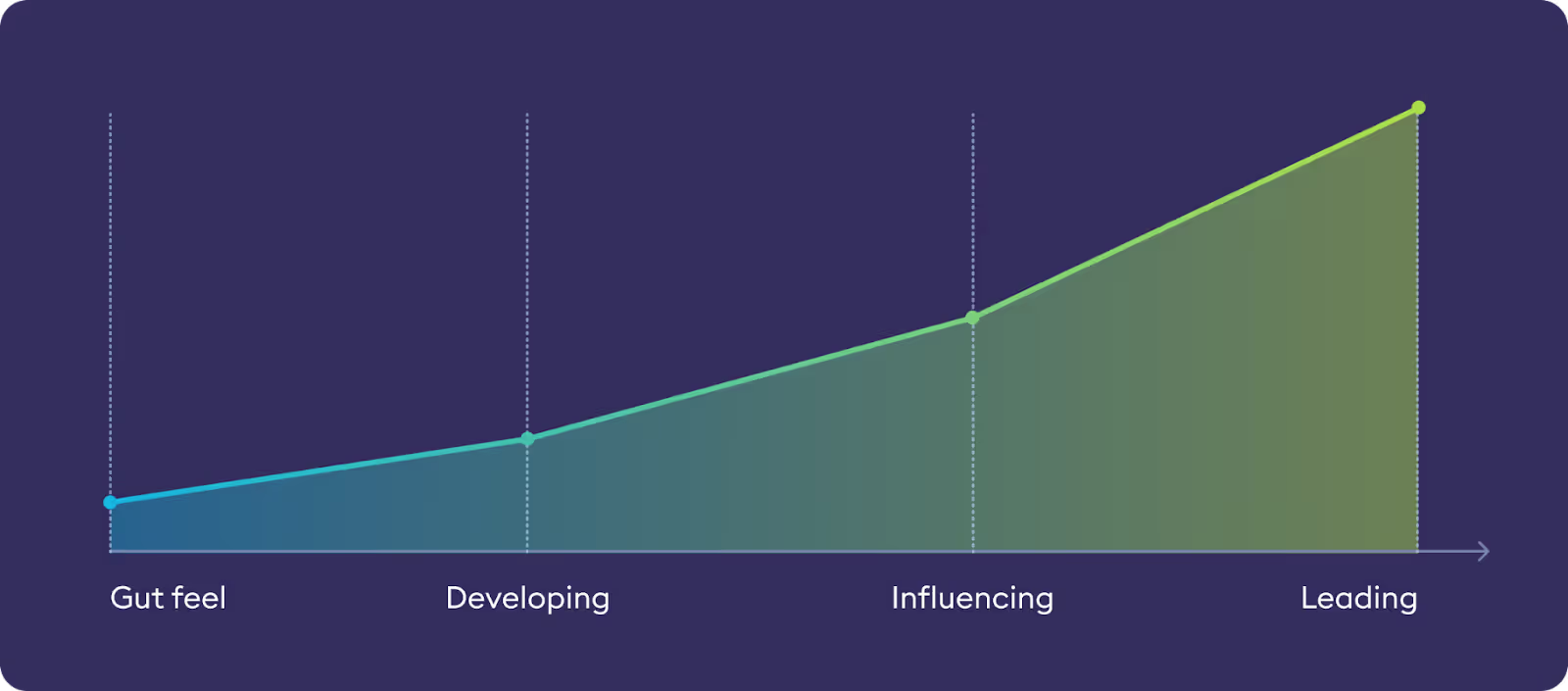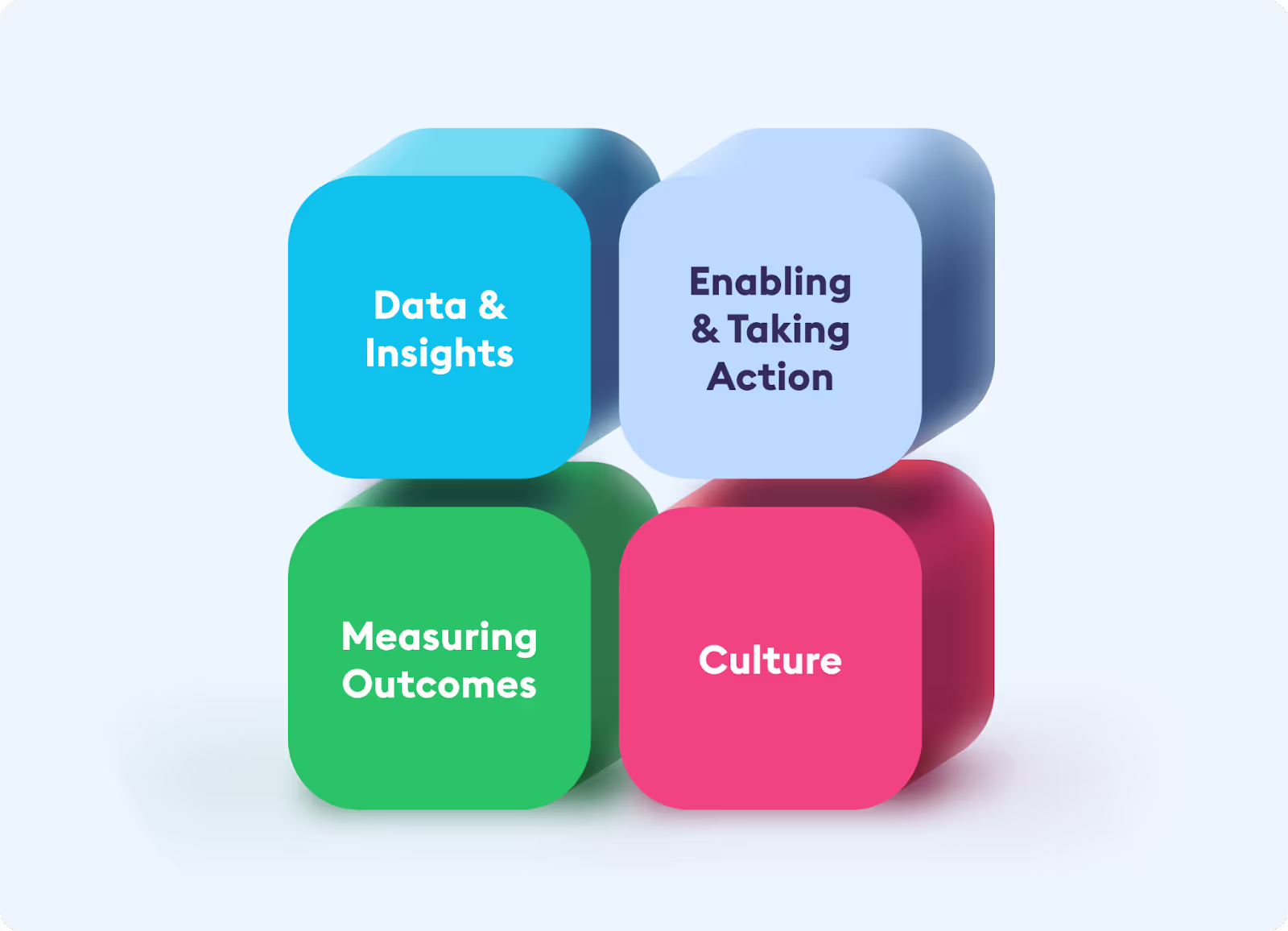The way your customers feel about your business impacts your profitability.
It’s a bold statement but it’s proven true time and again. It starts with the customer experience (CX) and ends with your bottom line.
Customer perception – the sum of emotions, opinions, expectations, values, and needs – drives behavior. That behavior is either beneficial or detrimental to your revenue.
And let’s face it, if customers are feeling neutral about your business, they belong in the detrimental bucket. Why? Because there’s no trust or loyalty attached to neutrality. Those customers are less likely to make repeat purchases and are highly susceptible to what your competitors offer.

So why aren’t all businesses operating a customer-centric model?
There’s a disconnect between executive and consumer opinion on critical issues of CX. For example, according to PwC’s 2024 Trust Survey, 90% of business executives think customers highly trust their company, when only 30% of customers say the same. That’s a staggering 60 point gap that can quite literally ruin a business or at least put a significant dent in profitability.
Failure to effectively understand how a customer perceives your company is one of the biggest reasons organizations struggle to achieve their business objectives. That’s true whether they want to drive repeat purchases, increase customer spend, or reduce customer churn – or deliver any other benefit or metric related to customer behavior.
The Experience-Led Growth Maturity Assessment provides an objective assessment of Experience-Led Growth (XLG) capabilities. Chattermill has developed a roadmap for any organization, regardless of their starting point, to improve their customer experience so they can deliver business objectives. It’s not a recommendation of best practice; it’s a meaningful assessment of where you currently sit combined with tailored recommendations to get you where you want to be.
Let’s dive in so you can discover how to improve your own customer experience and drive Experience-Led Growth.
The 4 stages of Experience-Led Growth maturity
A blueprint for Experience-Led Growth starts with the basics. Each company is assessed to determine their current XLG maturity level.

Stage 1: Gut Feel
- Defining feature: Limited or no XLG capabilities in place.
- Operational capability: Insight-driven decision-making is not possible.
- Obstacle for moving to next pillar: Customer experience and the insight-driven decision-making required to deliver it are not valued at an organizational level. Devoting resources to understanding customers is often seen as a priority for another day.
- Reason for concern: Exposed to disrupters in the market. New competitors often skip the Gut Feel pillar entirely because XLG is key to their success strategy.
While some customer experience data may be used as part of the decision-making process, decisions are effectively based on gut feel. Even where data is factored in, the low quality increases the risk it will contribute to existing biases and decisions will fail to deliver results.
Stage 2: Developing
- Defining feature: Some recognition of the need for customer experience data to support decision-making.
- Operational capability: Customer understanding and insight are incomplete and frequently based on ad-hoc work. There may be champions within the organization advocating for a greater level of customer understanding.
- Obstacle for moving to next pillar: Processes are not repeatable, standardized, or predictable. Biggest challenge is often not quite knowing how best to achieve change.
- Reason for concern: Customer Experience is recognized as useful but is not yet acted on as a high priority. Over time this can lead to disappointing results and an erosion of faith in the value of the customer's experience.
Top-line CX metrics are tracked and may be supported by greater insight relating to a specific touchpoint or stage of the customer journey. However, challenges with available data, insight capability, or resources limit customer-centric decision-making. Insight-driven action and tracking the impact of changes are not part of standard ways of working.
Stage 3: Influencing
- Defining feature: Consistent view of what customers think and feel, and a number of teams are consistently acting on this data.
- Operational capability: The processes in place are repeatable, process-driven and predictable.
- Obstacle for moving to next pillar: There are champions across the organization but CX is not yet truly the fundamental pillar of company strategy and approach.
- Reason for concern: Change in business philosophy or executive leadership could potentially refocus resources away from Experience-Led Growth.
The company has a number of the key elements of XLG in place and is using them effectively. They are focused on filling in the remaining gaps and improving processes. Long-term customer loyalty is valued more than short-term profit.
Stage 4: Leading
- Defining feature: Ruthless focus on XLG to consistently deliver business objectives.
- Operational capability: Unified data across touchpoints, channels, and stages of the customer journey for a comprehensive view of what the customer thinks and feels. Internal processes mean insights are democratized and form a fundamental part of decision-making. Able to measure the impact of the actions they take on core business metrics such as revenue.
- Reason for concern: Strong past performance can carry the risk of complacency or a reluctance to continually develop systems and processes to stay at the cutting edge of XLG.
XLG is effectively baked into the DNA of the organization. This confidence in the holistic customer understanding allows them to confidently and consistently make the right investments needed to stay ahead of competition. The company is focused on innovation and optimization, rather than fixing what’s not working.
The 4 pillars of Experience-Led Growth maturity
Once a business has identified what stage of maturity is currently operating in their organization, the next step is to assess how to create long-term profitability from Experience-Led Growth. To do that, it’s essential to know how to apply the four pillars of XLG Maturity.
Let’s take a look at each pillar in a little more detail. The questions associated with each one challenge a business to determine their current reality for each competency.

Pillar 1: Data and Insights
Genuinely understanding what customers think and feel across their journey with you and discovering actionable insights in the data.
Questions to ask yourself:
- How aware is your organization of the reality experienced by the customer?
- Are you able to consistently identify actionable customer insights?
- Is data being collected in a consistent way to ensure the insights derived from this data are reliable?
Pillar 2: Enabling and Taking Action
Getting customer insights into the hands of the right people in a timely manner so they can act to effect change.
Questions to ask yourself:
- Are customer insights being delivered to those who make decisions and take actions on the data?
- Are the insights timely?
- Is action consistently taken based on these insights into what customers think and feel?
Pillar 3: Measuring Outcomes
Understanding the impact of the changes you make for the business and how they are perceived by your customers. Knowing how to maximize the positive impact of changes in your organization.
Questions to ask yourself:
- Are the results of insight-driven action being measured?
- Are key stakeholders aware of the impact of actions being taken?
- Is there a learning loop to better understand actions and their outcomes?
Pillar 4: Culture
Decision-makers are motivated to drive customer-centric action and have corresponding KPIs to support them. Resources are devoted to optimizing and developing the skills and capabilities needed to understand and act on what customers think and feel.
Questions to ask yourself:
- Are those responsible for decisions and execution motivated to drive customer-centric actions?
- Do employees understand CX metrics and why they’re vital for long-term growth?
- Are resources – budget and people – allocated to enhance and develop your CX Intelligence?
The why behind the XLG Maturity Model
For organizations that are serious about achieving Experience-Led Growth, they need an objective view of what they are currently doing and what steps they still need to take to implement an experience-led approach.
Experience-Led Growth is a continuous process that requires each component to be functioning effectively for it to be successful. Organizations need to have the skills, competencies and processes in place to repeatedly take the right decisions.
With so many moving parts, it can be difficult to effectively diagnose how well you are doing and to prioritize where to focus efforts to improve. This is exacerbated by the fact that no two organizations are the same, which means each organization is starting from a different point. Individual elements that could be quite advanced in one organization could be at a much more basic level in another and vice versa.
This makes it essential to benchmark the current state of your Experience-Led capabilities and to use a data-driven approach to continually iterate and improve. The XLG Maturity Model provides the framework for an organization to measure progress as they develop and improve.
Moving from one XLG stage to the next is achievable but it’s not a simple undertaking. Focusing on the right improvements is the key to efficiently progressing to the next level. Businesses using the Chattermill XLG Maturity Assessment discover:
- What’s possible? – The XLG Maturity Assessment identifies what you can achieve at the top-line level. It also provides a detailed breakdown to show what best-in-class looks like across 17 different competencies.
- How can we get there? – The XLG Maturity Assessment provides a road map so you can plot a course to understanding what your customers think and feel about your brand regardless of your current situation and maturity stage.
- What capabilities do we need? – By breaking down specific skills and behaviors required in your organization, you can assess what you have in place and what you need to fill the gaps in your customer experience.
- How do we measure success? – The XLG Maturity Assessment provides an objective measure of the progress and improvements you are making to achieve the highest level of XLG maturity.
While it’s important to understand what best-in-class looks like, a realistic assessment of your own XLG focuses on the specific circumstances of your own organization. The XLG Maturity Assessment will steer you towards the required activities and the capabilities you need to meet your business goals.
Think about it this way. There’s no one-size-fits-all solution to mastering XLG for maximum growth. When optimized, your XLG is tailored to your business and no one else. You’ll discover things you are doing really well and others that require action to achieve improved profitability and growth.
Experience-Led Growth Maturity Assessment: The missing link to Experience-Led Growth

So what does this look like in practice? Chattermill has developed a framework to assess maturity on a scale of 1 to 100. The Assessment takes into consideration your current maturity across 17 different competencies and contrasts this with your business goals. Businesses are left with a clear idea about:
- Where they are on the maturity scale
- What they need to do to meet their goals
- What priorities they should give to tasks and activities
The full report includes visual representations and written assessments to give you the best understanding of the state of your XLG Maturity. You’ll get a complete assessment of your current competencies across each of the four pillars, including a comparative analysis contrasting your current levels with best in class. This allows you to draw a clear line from where you are to how those leading the field operate.
Depending on your business goals, you’ll have a variety of activities that will help you close the gaps and drive Experience-Led Growth. In addition to an objective assessment of your current reality provided by the maturity scoring, your report will include priority areas for you to focus on. Based on your current capabilities and goals, you will be given detailed recommendations on what actions to take and why. This includes identifying your existing strengths and observations about how you can do even better by building on existing competencies.
There will likely be a combination of quick wins that you can achieve in a matter of weeks and others that may take years. For example, improvements to data collection can often be implemented rapidly. Whereas effectively aligning teams or driving cultural change within the organisation are adjustments that can take considerably longer.
Regardless, you’ll have a clear idea about how you can begin to experience immediate gains in both understanding and acting on what your customers think and feel about your business.
Competencies used to assess XLG Maturity
The Overall Maturity Score recognizes your whole XLG ecosystem. However, the assessment provides much more than a single topline maturity level. Understanding the four pillars - as well as the scores for each of the individual competencies - provides a bespoke representation of your current XLG maturity.
This granular understanding of your existing maturity breakdown is what makes it possible to identify which actions should be prioritized. Two companies with the same overall maturity score could have entirely different action plans. Your organization may already be strong in one competency or pillar. At the same time, you could be working at a much more basic level in other competencies. The maturity assessment gives you solid insight into where your gaps exist and what you need to do to move the needle towards a better customer experience in each competency.
Delivering business objectives for Experience-Led Growth
With your maturity assessment completed, and your actions in hand, you’ll be able to fine-tune every part of your customer experience to meet your business objectives.

As your goals change, the XLG Maturity Assessment is an ideal way to ensure your organization is aligned to meet your new challenges and KPIs. Improving the experience of the customer is never a ‘set and forget’ exercise. It’s an iterative process that allows you to achieve growth goals at the departmental and organizational level.
Putting a decade of experience into Experience-Led Growth
Chattermill has worked for nearly a decade to help organizations understand their customer reality. Our goal is to remove the disconnect between what businesses believe about their customer experience and what the customer is actually feeling and experiencing.
We know the better you understand your customer experience, and the more consistently you work to improve it, for a longer period of time, the more likely XLG will be the key driver of your profitability.





